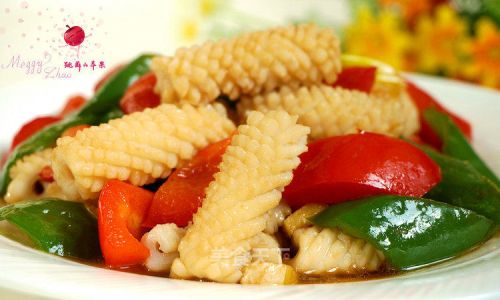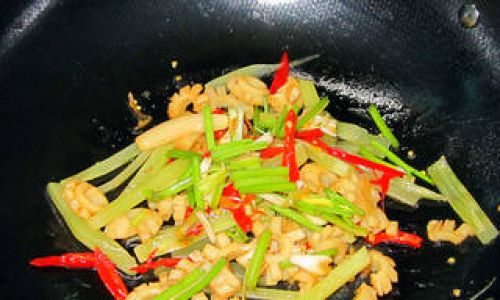Stir-fried squid rolls, a dish that tantalizes the taste buds with its delicate balance of tender squid, crisp vegetables, and savory sauce, is a staple in many Asian cuisines. Often served as an appetizer or a main course, this dish combines simplicity with complexity, requiring precision in preparation and cooking techniques. Whether you’re a seasoned home cook or a curious novice, this guide will walk you through every step to create restaurant-quality stir-fried squid rolls that impress.
Understanding the Dish
Stir-fried squid rolls, known in Chinese cuisine as chao you juan, are celebrated for their unique texture and flavor. The squid is lightly scored and rolled into cylindrical shapes, which not only enhances its visual appeal but also ensures even cooking. When stir-fried, the squid curls into tender, bouncy rolls, while the vegetables retain their crunch, and the sauce coats every bite with umami-rich goodness.
This dish’s popularity stems from its versatility. It can be adapted to suit various dietary preferences, from vegetarian twists to spicy variations, and pairs beautifully with steamed rice, noodles, or even a crisp salad. The key to success lies in mastering three elements: fresh ingredients, meticulous preparation, and precise cooking timing.
Ingredients: The Foundation of Flavor
Before diving into the cooking process, gather your ingredients. Freshness is paramount, especially when working with squid, as its delicate flavor can quickly turn rubbery if mishandled.

For the Squid Rolls:
- 1 lb (450g) fresh or frozen squid, cleaned and tentacles removed
- 1 tbsp rice wine (or dry sherry)
- 1 tsp cornstarch
- 1/2 tsp salt
- 1/4 tsp white pepper
For the Stir-Fry Sauce:
- 2 tbsp soy sauce (light soy for saltiness, dark soy for color)
- 1 tbsp oyster sauce
- 1 tsp sesame oil
- 1 tbsp rice vinegar
- 1 tsp sugar
- 1/4 cup chicken or vegetable broth
- 1 tsp cornstarch (mixed with 1 tbsp water to form a slurry)
For the Vegetables and Aromatics:
- 1 medium carrot, julienned
- 1 red bell pepper, thinly sliced
- 1 small onion, thinly sliced
- 3 garlic cloves, minced
- 1-inch piece ginger, grated
- 2 green onions, chopped (for garnish)
- 1-2 dried red chilies (optional, for heat)
Cooking Oil:
- 2 tbsp peanut oil (or vegetable oil)
Essential Kitchen Tools
To achieve perfect stir-fried squid rolls, equip your kitchen with the following tools:
- Wok or Large Skillet: A wok’s high sides and rounded base distribute heat evenly, ideal for stir-frying. If unavailable, a large cast-iron or stainless-steel skillet works.
- Sharp Chef’s Knife: Essential for scoring the squid and slicing vegetables uniformly.
- Cutting Board: Use a plastic board for seafood to prevent cross-contamination.
- Mixing Bowls: For marinating squid and preparing the sauce.
- Whisk or Spoon: To blend the sauce ingredients.
- Slotted Spoon: For removing cooked ingredients from the wok.
- Tongs or Spatula: For tossing ingredients during stir-frying.
Preparation: The Key to Tender Squid
Proper preparation ensures your squid rolls are tender, not rubbery. Follow these steps diligently:
-
Cleaning the Squid:
- If using fresh squid, pull the head and tentacles away from the body. Remove the ink sac and quill (a transparent cartilage) from the body cavity.
- Rinse the squid tubes under cold water, peeling off any purple membrane. This membrane can make the squid tough if left on.
- For frozen squid, thaw completely in the refrigerator, then pat dry with paper towels.
-
Scoring the Squid:
- Lay a squid tube flat on the cutting board, interior facing up.
- Using a sharp knife, make diagonal cuts about 1/8-inch deep at 45-degree angles, spaced 1/4-inch apart. Repeat in the opposite direction to create a crosshatch pattern.
- Scoring allows the squid to curl into rolls during cooking and helps it absorb flavors.
-
Cutting into Rolls:
- Slice the scored squid tube into 1.5-inch wide strips.
- Roll each strip tightly into a cylinder and secure with a toothpick if needed (remove before serving).
-
Marinating the Squid:
- In a bowl, combine squid rolls, rice wine, cornstarch, salt, and white pepper. Toss gently to coat.
- Marinate for 15–20 minutes at room temperature. This step tenderizes the squid and seasons it lightly.
-
Prepping Vegetables and Aromatics:
- Julienne the carrot, slice the bell pepper and onion into thin strips, and mince garlic and ginger.
- Prepare the sauce by whisking together soy sauce, oyster sauce, sesame oil, rice vinegar, sugar, and broth. Set aside.
Cooking Process: Mastering the Stir-Fry
Stir-frying is a high-heat, quick-cooking method that requires focus and speed. Follow these steps for flawless execution:

-
Heating the Wok:
Place the wok over high heat until it begins to smoke. Add 1 tbsp of oil and swirl to coat the surface.
-
Stir-Frying Vegetables:
- Add garlic, ginger, and dried chilies (if using) to the hot oil. Stir-fry for 10–15 seconds until fragrant.
- Toss in onions, carrots, and bell peppers. Stir-fry for 2–3 minutes until vegetables are crisp-tender. Remove from the wok and set aside.
-
Cooking the Squid:
- Wipe the wok clean and return it to high heat. Add the remaining 1 tbsp of oil.
- Drain the squid rolls from the marinade (reserve the liquid) and add them to the wok in a single layer.
- Cook undisturbed for 30 seconds to sear, then stir-fry for 1–2 minutes until the squid curls and turns opaque. Avoid overcooking, as squid becomes rubbery quickly.
-
Combining Ingredients:
- Return the vegetables to the wok. Pour in the prepared sauce and the reserved marinade liquid.
- Toss gently to coat all ingredients. Bring the mixture to a simmer.
-
Thickening the Sauce:
Stir the cornstarch slurry and pour it into the wok. Cook for 1–2 minutes, stirring constantly, until the sauce thickens and glazes the squid and vegetables.
-
Final Touches:
- Remove from heat. Stir in half of the green onions.
- Transfer to a serving platter and garnish with the remaining green onions.
Tips for Perfect Squid Rolls
- Scoring Depth: Avoid cutting too deeply into the squid, as this may cause it to fall apart during cooking.
- High Heat: Ensure your wok is smoking hot before adding oil. This prevents sticking and sears the squid quickly.
- Timing: Squid cooks in minutes. Overcooking beyond 2–3 minutes will result in toughness.
- Sauce Consistency: Adjust the cornstarch slurry if you prefer a thicker or thinner sauce.
- Resting Time: Let the squid marinate for at least 15 minutes to tenderize, but avoid marinating longer than 30 minutes, as the enzymes in squid can break down the flesh excessively.
Variations and Customizations
Stir-fried squid rolls are incredibly adaptable. Experiment with these twists:
- Spicy Kick: Add 1 tbsp of chili paste or fresh bird’s-eye chilies to the sauce.
- Citrus Zing: Squeeze fresh lime juice over the finished dish for brightness.
- Vegetarian Option: Replace squid with king oyster mushrooms or tofu, sliced and scored similarly.
- Herbaceous Notes: Toss in fresh basil, cilantro, or mint leaves just before serving.
- Nutty Crunch: Garnish with toasted sesame seeds or crushed peanuts.
Serving Suggestions
- Pair with Rice: Serve over jasmine rice or coconut rice to soak up the sauce.
- Noodle Companion: Toss with udon noodles or thin rice noodles for a heartier meal.
- Appetizer Platter: Arrange squid rolls on a bed of lettuce with a side of sweet chili dipping sauce.
- Wine Pairing: A crisp Riesling or lightly oaked Chardonnay complements the dish’s delicate flavors.
Health Benefits of Squid
Squid is a lean source of protein, rich in vitamins B12 and B6, selenium, and copper. It’s low in saturated fat and calories, making it a healthy addition to your diet. When stir-fried with minimal oil and fresh vegetables, this dish becomes a nutritious powerhouse.
Troubleshooting Common Issues
- Rubbery Squid: Overcooking is the primary culprit. Remove squid from heat as soon as it curls and turns opaque.
- Soggy Vegetables: Stir-fry vegetables separately to maintain crispness. Overcrowding the wok lowers heat and steams vegetables instead of searing them.
- Bland Flavor: Ensure the sauce is well-seasoned and balanced. Taste and adjust before adding to the wok.
Conclusion
Stir-fried squid rolls are a testament to the beauty of simplicity in cooking. With fresh ingredients, precise techniques, and a dash of creativity, you can transform humble squid into a dish that delights the senses. Whether you’re hosting a dinner party or craving a quick weeknight meal, this recipe offers a gateway to culinary excellence. So, roll up your sleeves, heat the wok, and embark on a journey to master the art of stir-fried squid rolls—your taste buds will thank you.





0 comments